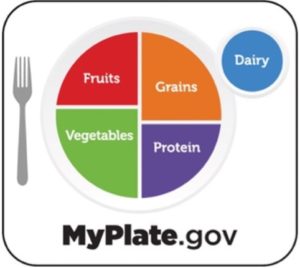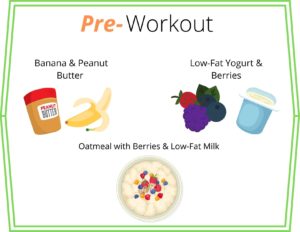Now that you have begun your fitness journey through your OrangeThoery workouts you have probably begun to wonder what the next step is in order to achieve your fitness goals. To make your fitness goals a reality you should begin to focus on your eating patterns and the role nutrition plays in weight management and your overall health and wellbeing.
What we eat has an important role in supporting our health and preventing chronic disease. 4 of the top 7 leading causes of death, heart disease, cancers, stroke, and diabetes, in United States can linked to diet and physical activity (Whitney & Rolfes, 2019). One keyway that diet and physical activity are associated with these diseases is through weight management. For many OTF members weight management is the primary goal and first step taken in chronic disease prevention. Let’s discuss how you can continue towards your weight management and fitness goals by combing your hard work at OTF with nutrition.
Relationship between nutrition & physical activity
Our bodies are constantly using energy for involuntary processes such as maintaining stable temperature, breathing, bumping blood along with voluntary functions like walking and talking. The energy to perform these functions is provided by the food we eat. Each of required a different amount of energy or calories to maintain our weight and complete all of these voluntary/involuntary functions. When the number of calories we consume is greater than the energy we need extra energy is stored as fat and our weight increases. In contrast, when we consume fewer calories than is required our bodies will use stored energy or fat and we will lose weight (Whitney & Rolfes, 2019). This concept is often illustrated as a scale like the one below. The goal when focusing on weight management is to tip the scale in the direction that you want your weight to go.
Your hard work during your OTF classes helps to tip the scale so that your energy output is greater than the calories you take in. However, you may find that simple increasing your activity is not enough to promote weight loss. In this case, decreasing your caloric intake may be helpful. When beginning to reduce the number of calories you consume it is important to remember intense energy restriction can lead to metabolic changes resulting in slowed weight loss, muscle loss, and impaired athletic performance. It is advised to use moderate calorie restriction (500-700 kcal/d) to promote weight loss and maintain athletic abilities. This moderate calorie restriction allows the individual to develop new habits that support their exercise training (Odysseos, & Avraamidou, 2016).
Nutrition basics for active individuals
As mentioned earlier, the food we eat plays an important role in maintain our bodily functions. This is also true when discussing how nutrition impacts our athletic performance and how much we can achieve during the OTF workouts. Food consists of different components called macro and micronutrients. The macronutrients include carbohydrate, protein, and fats. Each of these nutrients has a different essential role in the body. Carbohydrates are the body’s primary energy source. It is recommended to consumed approximately 45-55% of your total calories as carbohydrates. When exercising glucose from carbohydrates provide us energy during endurance exercises. It is important to ensure that you have enough carbohydrates both before and after each workout. Protein provides the building blocks for muscle synthesis, hormones along with completing many other functions in the body. When inadequate quantities of protein are consumed individuals will initially notice slower muscle recovery with long term effects including muscle wasting, injuries, illness, and even training intolerance (Kerksick et al, 2018). Similar to carbohydrate, these negative effects can be avoided by ensuring adequate intake of protein before and after each workout. Lastly, fat acts as another form of energy and important for various other bodily function such as maintaining body temperature and cell membranes. When exercising, the body will utilize fat an energy during aerobic activity like running on the treadmill (Whitney & Rolfes, 2019).
In addition to the micronutrients, maintaining adequate hydration is essential. Research has shown that exercise performance decreases when 2% or more of body weight is loss via sweat. The best way to ensure that this does not occur is to drink plenty of water throughout the day (Kerksick et al, 2018).
Creating balanced meals and snacks
Now that we know what role each nutrient plays, let’s talk about this looks on your plate.

When putting together meals and snacks focus on including fruits and vegetables, whole grains, and a variety of protein foods such as poultry, legumes, seeds, and nuts. Begin by filling half of your plate with fruits and vegetables like the MyPlate image to t
he right (USDA, n.d.). Fruits and vegetables provide the body with carbohydrates and has been associated with decreased BMI, waist circumference, and percent body fat (Yu et al., 2018). They also provide your body essential vitamins, minerals, and hydration. Non-starchy fruits and vegetables such as, broccoli, carrots, and peppers are nutrients-dense foods. That means they contain high amounts of vitamins and mineral with lower a lower calorie count. Increasing the quantity of fruits and vegetables in your plate will help decrease your total caloric intake. Next, include lean proteins. Consuming a variety of lean protein items will ensure efficient muscle recovery with minimal saturated fat consumption. Saturated fat intake has been associated with increased prevalence of overweight /obesity and risk of chronic disease. The last component of a balanced meal is grains. When picking out your grains opt for whole grains such as brown rice, quinoa, or whole wheat bread. Whole grain products have all of the nutrient and fiber found in the original grain.
Timing of meals and snacks
The timing of your meals and snacks is important to ensure that you have enough energy to complete you OTF workout, especially when restricting calories. The International Society of Sports Nutrition recommends consuming a meal or snack containing protein every 3-4 hours (Kerksick et al, 2018). For some of us this may be possible by consuming 3 meals and 2 snacks per day. However, for many of use works schedule and daily commitments do not allow for consuming small frequent meals. When this is the case the components and timing of your pre- and post-workout snacks is essential.
Pre-workout snacks should be consumed 30-60 minutes before your workout and include about 50g carbohydrate and 5-10g of protein. This combination will ensure that your body has enough glucose to maintain energy during the entirety of the workout and reduce muscle breakdown. Try one of these easy snacks before your next workout.

Post-workout snacks should be consumed within 30 minutes after your workout is complete and consist of 2:1 ratio of carbohydrates to protein (Kerksick et al, 2018). Consuming both carbohydrates and protein after a workout allows the body to restore its energy stores and promotes muscles synthesis. Try one of these easy post-workout snacks.

Using these nutrition tips and consuming a balanced diet you will be able to support your body through each OTF workout and continue to get closer to your weight management goals.
Resources
Kerksick, C. M., Wilborn, C. D., Roberts, M. D., Smith-Ryan, A., Kleiner, S. M., Jäger, R., … & Kreider, R. B. (2018). ISSN exercise & sports nutrition review update: research & recommendations. Journal of the International Society of Sports Nutrition, 15(1), 1-57.
Odysseos, C., & Avraamidou, M. (2016). Weight management for athletes: Important things to be considered. Arab Journal of Nutrition and Exercise (AJNE), 155-170.
USDA. (n.d.). What’s on your plate? Retrieved March 28, 2021, from https://www.myplate.gov/
Whitney, E., & Rolfes, S. R. (2019). Understanding Nutrition (15th ed.). Boston, MA: Cengage.
Yu, Z. M., DeClercq, V., Cui, Y., Forbes, C., Grandy, S., Keats, M., … & Dummer, T. J. (2018). Fruit and vegetable intake and body adiposity among populations in Eastern Canada: the Atlantic Partnership for Tomorrow’s Health Study. BMJ open, 8(4), e018060.
Leave a Reply